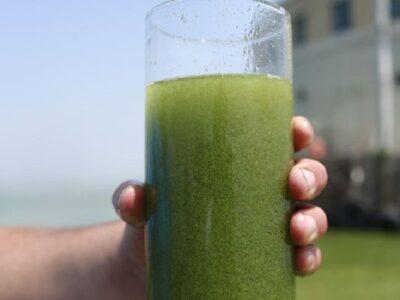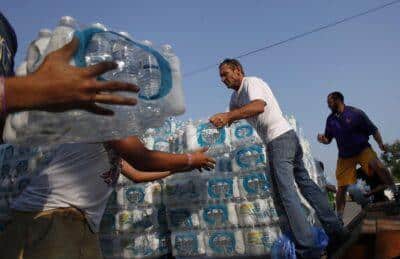|
Listen To The Article
|

Image source: USA Today
The residents of Toledo, Ohio, a metropolitan area with nearly half a million residents, were in an almost unimaginable situation for an entire weekend: Their tap water was unsafe to drink, bath in or even cook with.
And it all was due to man-made causes.
People in Northeast Ohio and Southeastern Michigan suddenly lost what most Americans and Canadians take for granted: safe clean tap water.
“It’s murky and green — nothing I would swim in,” Toledo resident Katie Peters said of the water in Lake Erie, the local water source. “It’s sort of like the wicked witch from ‘The Wizard of Oz’: lime green.”
The situation forced Peters to drive an hour to a Walmart store in Michigan to purchase bottled water, The New York Times reported. Other Toledo residents stood in line as the National Guard handed out water to area residents.
What Happened To Toledo’s Water
The algae bloom apparently occurred because of high levels of phosphorous due to artificial fertilizer runoff from large scale farms, as well as from sludge from sewage treatment plants.
Ultra Efficient Water Filter Fits In Your Pocket!
The amount of phosphorus in the Great Lakes needs to be reduced to prevent similar catastrophes from occurring in the future, the International Joint Commission, a Canadian-American government taskforce responsible for the lakes’ health, advised last year.
An Ohio state taskforce recommended reducing the amount of phosphorous in the lakes by 40 percent to keep the drinking water safe, AP reported. Like the commission, the Ohio taskforce believes more algae blooms and water contamination disasters are possible.
“It’s very possible,” Laura Johnson, a research scientist at the National Center for Water Quality Research at Heidelberg University in Tiffin, Ohio, told USA Today. The blooms often are at their worst in September. “What’s really scary is it’s so early in the season.”
The algae boom produced high levels of microcystin, a toxic substance that can damage the liver and cause diarrhea and vomiting in water even after being treated at water treatment plants. The EPA does not regulate microcystins.

Image source: NationalGeographic
As a precaution, Mayor D. Michael Collins warned residents not to use the water for drinking, bathing, cooking or dish washing. He even warned residents not to boil water because microcystin cannot be removed by boiling.
Mayor Collins lifted the water use ban on Monday, two days after it was put in place. Prior to that, restaurants closed because dishes could not be washed and hospitals cancelled elective surgeries because they couldn’t use water to clean equipment. Some medical facilities even shipped equipment to other cities in order to get it clean.
Officials are scrambling to prevent such algae blooms from occurring again. Several major cities, including, Chicago, Toronto, Detroit, Buffalo, Cleveland and Milwaukee, get their water from the Great Lakes. Around 11 million people rely on water from Lake Erie alone.
What You Can Do to Protect Your Family
There’s a lesson here: Safe drinking water can vanish almost instantly. Families and businesses need to start preparing for such a contingency.
Some steps you can take include:
- Purchase an emergency water purification system for your home. There are a number of good products on the market, and some of them are portable and capable of making water safe without electricity. Some even allow you to drink water out of a lake or river.
- Keep enough water in your house to sustain your family for several days. Just a few large bottles like those used in water coolers can meet your needs. If you have a water cooler, buy or order a few extra bottles and keep them handy.
- Investigate alternative sources of water such as rain water, wells, springs and streams in your area.
Those things we take for granted, such as clean water or electricity, can disappear suddenly — and without warning.
Do you have water crisis tips? Share them in the comments section below.
Sign up for Off The Grid News’ weekly email and stay informed about the issues important to you
 Off The Grid News Better Ideas For Off The Grid Living
Off The Grid News Better Ideas For Off The Grid Living



